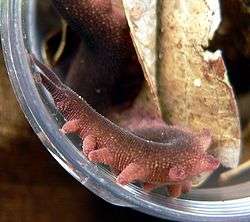Eoperipatus totoro
| Eoperipatus totoro | |
|---|---|
 | |
| First known specimen of Eoperipatus totoro | |
| Scientific classification | |
| Kingdom: | Animalia |
| Phylum: | Onychophora |
| Class: | Udeonychophora |
| Order: | Euonychophora |
| Family: | Peripatidae |
| Genus: | Eoperipatus |
| Species: | E. totoro |
| Binomial name | |
| Eoperipatus totoro Oliveira et al., 2013 | |
Eoperipatus totoro is a species of velvet worm of the Peripatidae family.[1] It is found in Vietnam.[2]
Taxonomy
The first specimen was caught in Cát Tiên National Park, Vietnam by P.V. Kvartalnov, E.A. Galoyan and I.V. Palko from the Lomonosov Moscow State University and Vietnam-Russia Tropical Centre in November 2007.[2] This velvet worm was described for the first time in 2010 by Vietnamese researchers Thai Dran Bai and Nguyen Duc Anh.[3] But formal description was made only in June 2013 by a team led by Georg Mayer and Ivo de Sena Oliveira from the University of Leipzig, Germany. The type specimen was a male caught in 2009 by Peter Geissler from the Alexander Koenig Research Museum. Found in the Crocodile Lake area of the Park, it is so far the only velvet worm described from Vietnam, although at least one other undescribed species lives in the country.[4] Before 2013, only three valid species of Eoperipatus were recognised in Southeast Asia, and E. totoro as a distinct species was confirmed using detail data from scanning electron microscopy and molecular analysis (mitochondrial COI and 12S rRNA sequences).
The generic name Eoperipatus is derived from an Ancient Greek combining form of ēṓs, meaning "dawn", and peripatos, meaning "walking about". The specific name totoro refers to the Japanese animated film My Neighbor Totoro. The collectors of the first specimen requested it be named totoro as they were reminded of the multiple legged caterpillar-like Catbus in the film when they saw the crawling velvet worm.[5]
Description
Unlike other velvet worms, Eoperipatus totoro has uniquely shaped hairs on its body surface. The body length is up to 2.5 inches (6 cm). These worms spend most of their lives inside moist soil, in rotting logs or under rocks. They come out only during rainy season, and therefore, are not easily seen. They can spit out jets of sticky glue, by which they capture small prey for food. They eject a net of glue from two appendages on their back. The glue is composed of a mixture of proteins in which prey can be entangled.[4] Diagnostic features include distinct types of scales on the ventral side of the body, the inner structure of the circular pits on the male genital pad, and the position and size of the anal gland pads in males.[5]
References
- ↑ Oliveira I., Hering L., & Mayer, G. "Updated Onychophora checklist". Onychophora Website. Retrieved 24 November 2016.
- 1 2 Pavel Kvartalnov (25 November 2007). "About Totoro [in Russian]". livejournal.com. Retrieved 8 September 2013.
- ↑ Thai Dran Bai; Nguyen Duc Anh (2010). "Discovery of Eoperipatus sp. (Peripatidae), the first representative of Onychophora in Vietnam". Journal of Biology (Hanoi). 32: 36–39.
- 1 2 Douglas Main (21 August 2013). "New Glue-Spitting Velvet Worm Found in Vietnam". livescience.com. TechMedia Network. Retrieved 28 August 2013.
- 1 2 Oliveira Ide S, Schaffer S, Kvartalnov PV, Galoyan EA, Palko IV, Weck-Heimann A, Geissler P, Ruhbergh H, Mayer G (2013). "A new species of Eoperipatus (Onychophora) from Vietnam reveals novel morphological characters for the South-East Asian Peripatidae". Zoologischer Anzeiger. 252 (4): 495–510. doi:10.1016/j.jcz.2013.01.001.